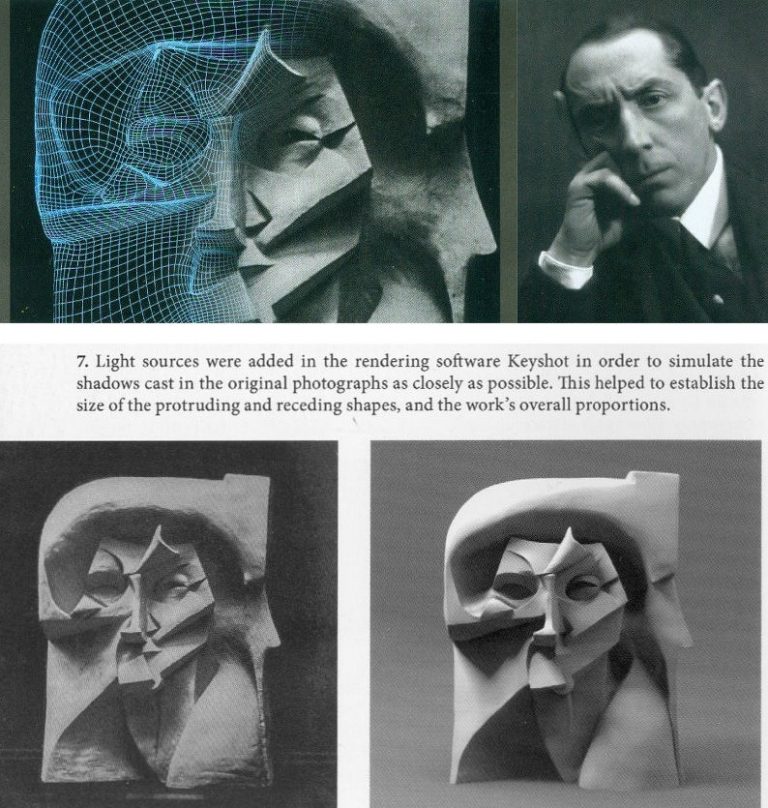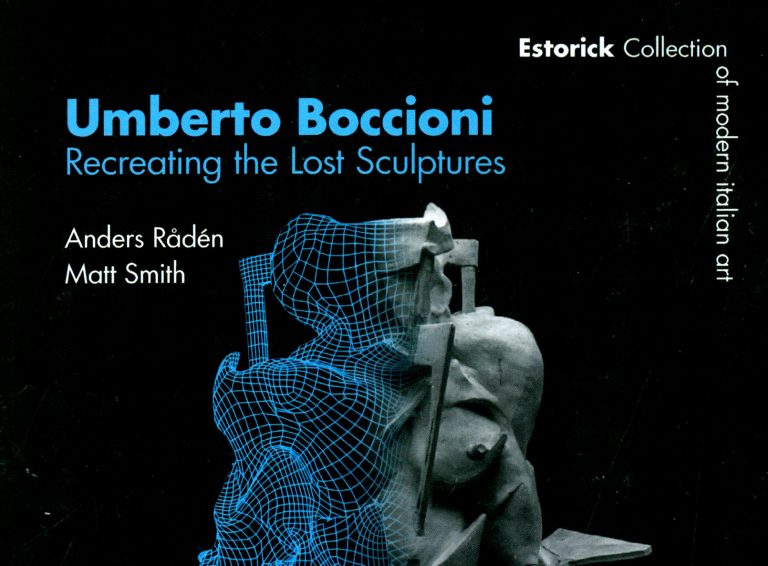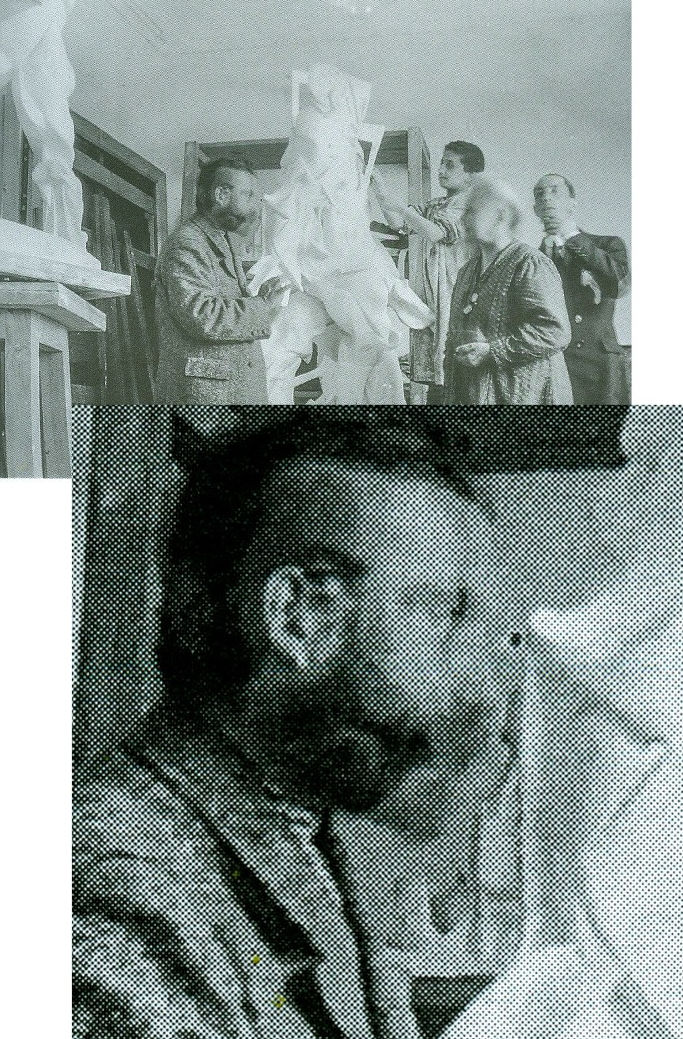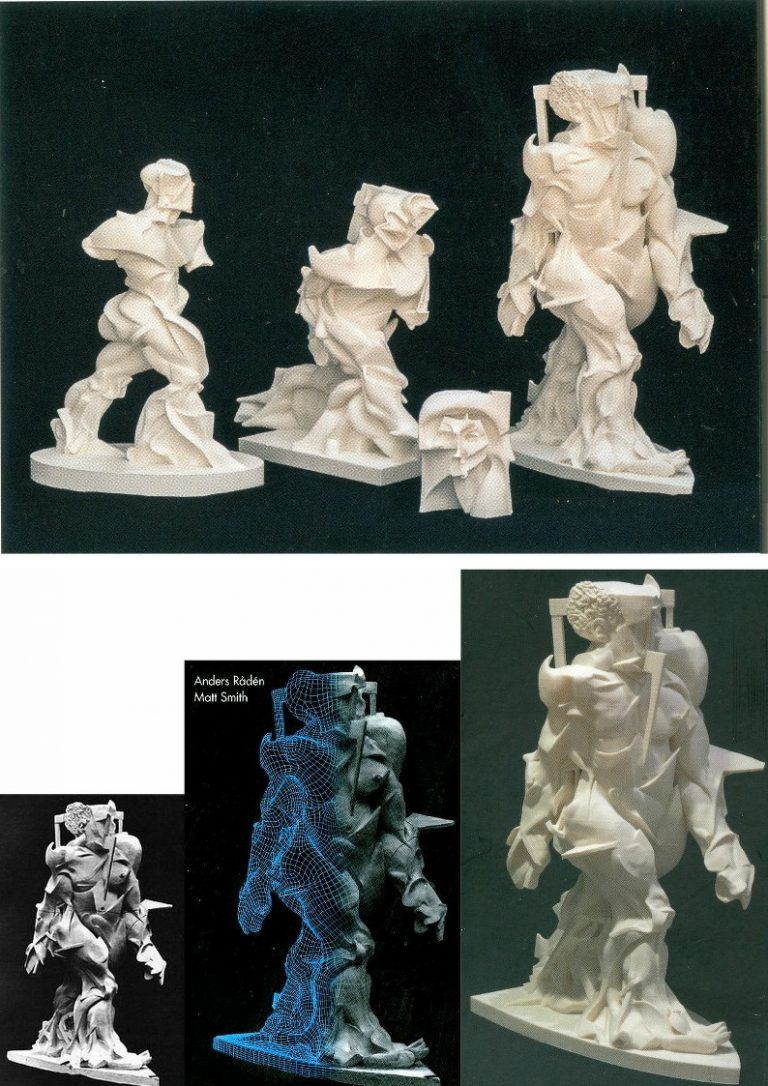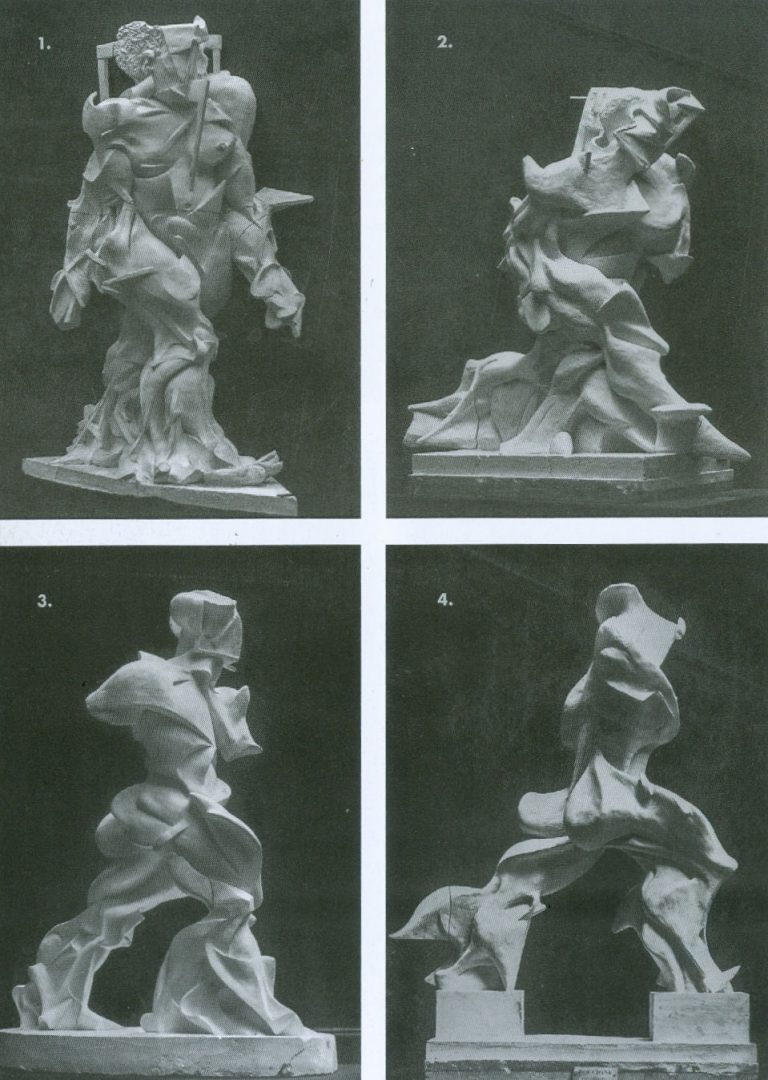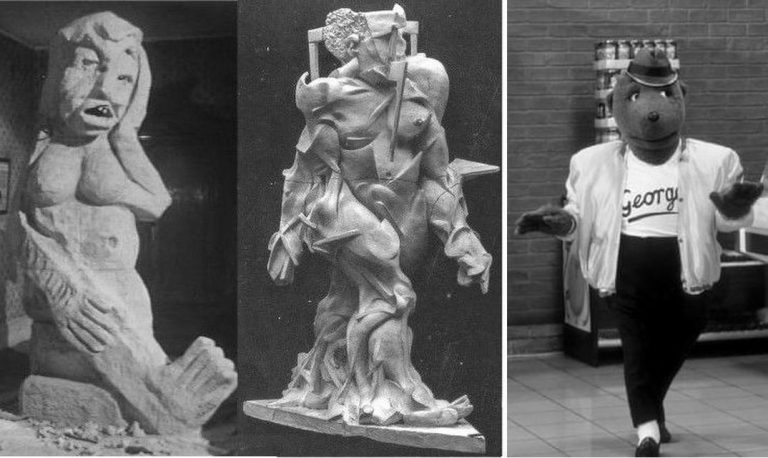A fascinating and ground-breaking show – Umberto Boccioni: Recreating the Lost Sculptures – centres on four three-dimensional recreations of Boccioni’s lost plaster and mixed media sculptures. This exhibition – running at the Estorick Collection, London, until 22 December – prompts far-reaching technical, artistic and art historical questions.
Above, Fig. 1: Top left, a detail of a 1913 photograph of a lost sculpture Empty and Full Abstracts of a Head with a superimposed reconstructed 3D mesh; top right, Umberto Boccioni, c. 1914; below, a note on the technical means of the presently exhibited recent recovery/replications.
THE TECHNICAL/INTERPRETIVE PROBLEMS
The wizardry whereby old photographic records of lost sculptures were aggregated to produce digitally “virtual”, in-the-round, simulations of sculptures to be printed out or milled in 3D is well-described in an excellent catalogue. This “recovery” or “recreation” of sculptures that were destroyed in 1927 was made by two digital artists and designers, Anders Rådén and Matt Smith.
Above, Fig. 2: Detail of the catalogue cover. Rådén and Smith acknowledge that technical difficulties required a degree of interpretation and creativity in what are necessarily provisional reconstructions: “the discovery of new or better photographs will always necessitate a rethinking of certain shapes”. Inconsistencies of surface finish and sometimes forms emerge between the new simulations and old photographic records – as was also the case with the bronze casts of plaster sculptures made after Boccioni’s death. Such notwithstanding, the authors’ hopes that fresh insights into Boccioni’s sculptural practice will offer new interpretive opportunities for specialists and the general public are not vain: accepted as what they are, even a part-hypothesized proximate and provisional physical recovery of four lost sculptures that were made at a crucial stage of Boccioni’s late development can assist appraisals of the oeuvre of a seminal figure who, personally and professionally speaking, remains problematic.
WHITHER BOCCIONI’S FUTURIST EYE?
Among early 20th century noisy proselytising art movements, Italian Futurists were obnoxious for their ultra-nationalistic, proto-Fascist fervour; their international cultural competitiveness and their affected cults of death and destruction. Speed and industrialization were glorified. War was hymned as the world’s “only true hygiene”. Explosions were likened to flowers. Past artistic glories were excoriated – museums were cemeteries and mausoleums; traditions were contaminations to be excised. Boccioni’s proclaimed terror of being crushed by past cultural attainments triggered his demand that everything had to go: “In the monuments and exhibitions of every European city, sculpture offers a spectacle of such pitiable barbarism, clumsiness and monotonous imitation that my Futurist eye recoils from it with profound disgust!” All nations, he held (Technical Manifesto of Futurist Sculpture, 1912), were being crushed by blind, foolish and cowardly adherence to past cultural attainments that ranged from Greece and Michelangelo to Slavic countries with their “archaic Greek and Nordic and Oriental monstrosities, a shapeless mass of influences that range from the excess of abstruse details deriving from Asia, to the childish and grotesque ingenuity of the Lapps and Eskimos.” Boccioni further complained of “Greek-ized Gothicism sweetened with effeminate care by German pedantry” and saw the public as “scum whom we must lead into slavery”.
This belligerent naughty movement par excellence was doubly parasitical and brazenly hypocritical. A century on, Boccioni’s position is assured. He is in the art history books. His works are in great museums and prosper on the market: on 12 November 2019 a bronze cast of his now iconic Unique Forms of Continuity in Space sold for $16.1 million – appreciably more than the $4.8 million achieved the following day by a recently discovered Artemisia Gentileschi Lucretia – albeit while dramatically less than Jeff Koons’ silvered bunny which made $91 million this year.
A MONUMENTALLY PROVOCATIVE AND MYSTIFYING PROSPECTUS
Above, Fig. 3: Top, Boccioni with his mother, an assistant and, left, Giacomo Balla; below, right, Balla’s head caught in double exposure. Boccioni was nothing if not philosophically and programmatically ambitious: the “means of achieving the complete renewal of this mummified art”, he insisted, would only be possible if “the essence [of Art] itself” were renewed. Constructing with elements drawn from Egypt, Greece, or Michelangelo was like “wanting to draw water from a dry well with a bottomless bucket”. At the same time he (initially and perhaps, even essentially, a painter) betrayed a lack of sculptural self-confidence – even if and when purged of historical contaminations, sculpture would remain subservient to painting which had “taken on a new life, profundity, and breadth through a study of the landscape and the environment, which are made to react simultaneously in relation to human figures or objects, reaching the point of our Futurist INTERPENETRATION OF THE PLANES [Technical Manifesto of Futurist Painting, 11 April 1910].” On that deferential prospectus, it was hoped that: “In the same way sculpture will find a new source of emotion, hence of style, extending its plastic quality to what our barbarous crudity has made us think of until now as subdivided, impalpable, and thus plastically inexpressible.”
Above, Fig. 4: Top, the four digitally and plastically reconstituted sculptures, as printed in 1/4 scale, these being, from the left, top: Spiral Expansion of Muscles in Movement; Speeding Muscles; Empty and Full Abstracts of a Head, and Synthesis of Human Dynamism. Below them are: left, Boccioni’s sculpture Synthesis of Human Dynamism as photographed when first constructed in plaster; centre, as part-described in 3D mesh form and part as originally realised; and, right, as when wholly reconfigured by 3D printing.
Above, Fig. 5: Rådén and Smith’s (persuasive) proposed chronological sequence of Boccioni’s four striding figures based on stylistic similarities and evolving shapes – showing, as from 1 to 4, Synthesis of Human Dynamism, Speeding Muscles, Spiral Expansion of Muscles in Movement and Unique Forms of Continuity in Space. This sequence bears witness to a dramatically critical “late period” development (1912-13) in the artist’s short life (he died in 1916 on a military exercise).
What might be said of this evolution? On his own programme, Boccioni sought not to construct sculptural bodies but three-dimensional records of “a body’s action”. He initially worked with multiple materials in an “architecture of the pyramid” which he abandoned for one of “the spiral”. He disclaimed any quasi-cinematographic freezing of discrete figural moments and any notion of an immobile body being set in motion. He expressly postulated an inherently dynamic body – “a truly mobile object, which is an absolutely new and original living reality. In order to represent a body in motion, I do not render its trajectory – that is to say, its passage of one state of rest to another – but strive to capture the form that expresses its continuity in space.” If such an aspiration is thought to have been realised in his Unique Forms of Continuity in Space, it followed much synthesizing of manifestly concrete realisations of forms and trajectories. The authors of this recent exercise in replication have performed great service by fleshing out the photo-record of what was, by any standards, a remarkably swift genesis of an arresting and encapsulating motif. Now that the entire sequence of those figures-in-movement can be comprehended in our own lived spaces, the question arises: What carried Boccioni so very swiftly from Figure 1 to the acclaimed and ambitiously conceived Figure 4?
In 1958 Marianne Martin lauded Boccioni’s Unique Forms of Continuity in Space as a summation of his endeavours and an embodiment of the Futurist ideal of the modern man: “…he is impersonal and unsentimental, clean, clear cut, and disciplined, intelligent but unphilosophical, masculine yet without sexual passion. His strength and capabilities are magnified a hundredfold through science which is conceived by him. He strides majestically and weightlessly on winged feet, forcing ‘the muscles… into streamlined shapes as if under the distorting pressures of supersonic speed’ [Alfred H. Barr Jr.].” Notwithstanding such heroising accounts, the arc of Boccioni’s artistic development betrays indebtednesses at every turn to both his contemporaries and artistic glories of the past against which he railed.
A RAPID STYLISTIC TRANSFORMATION
Above, Fig. 6: From left to right, Aphrodite at the Watering Hole, as featured in the 1961 film The Rebel; Boccioni’s Synthesis of Human Dynamism; George-the-Bear as featured in the 1980s advertising campaign for Hofmeister lager. Boccioni’s assumed “start of sequence” (No. 1) figure, Synthesis of Human Dynamism, is a near-incoherent seeming depiction of a lumbering, part-armoured, part-flayed human figure; a disturbing, mongrel conflation of the deconstructed and reconstructed peppered with penetrating symbolic and literal motifs/devices like a modern day secular St. Sebastian. Rådén and Smith tactfully compare this (and the assumed second figure) unfavourably with the last two figures on account of being: “characterised by a sense of heaviness and complexity of form that renders their ‘movement’ far more staccato” than the latter two in which are eliminated “those extraneous details…such as the hair, nipple and navel…and the architectural elements”. The emphatic navel and nipples and sharply upturned foot are precisely encountered in the 1961 film The Rebel’s spoof-modernist Aphrodite sculpture. Similarly, No. 1’s gait, with its line-ahead feet, see-sawing shoulders and balance-assisting hands anticipated George-the-Bear in the 1980s British Hofmeister beer advertisements.
Body No. 2 effects a huge transition from lumbering horror-film apparition to a racing figure: the head comes down to reduce wind resistance; the feet fly and the leading leg leaves a succession of “before” positions in a bridged supporting triangular wall. The hands and arms are drawn into the now compacted upper body which leans into the motion as if pulling and willing the legs that transport it. The former painfully impacted planes of window frames and such at No. 1 are being digested and incorporated within the body’s armoured architecture.
Quantum leaps occur at No.3. The arms are now as much implicit as sculpturally realised; the legs separate, articulating a wedge of space and with each leg becoming an individual powerhouse of accumulated replications of “musculature” and hard, bony or armoured forms (shin turning into snow plough); the combined forms of the lower legs suggest the pulling power of a dray horse; the figure proceeds in stately purposive fashion as if advising its predecessor “Less Haste, More Speed”. Paradoxically, the legs’ aggregated trajectories congeal into stolid pyramids that root the figure to its base thereby rendering it immobile, arrested and frozen in time. The double breakthrough of interpenetrating space, and a dramatically contracting torso came within a year of the exhibiting of Rodin’s The Walking Man and Archipenko’s six-feet high prepossessing and lucid carved Family Life – Fig. 7, below.
Boccioni’s final figure begins to take flight and vault chasms: the forms thin-down, like those of a carcase left shriven in the sun, and yet stretch, curve and bite on the air like propeller blades. The torso is further de-humanised: the arms are gone; the “head” becomes vestigial, hollowed and mask-like in one aspect. Where, in No. 3, the lower legs are rooted to the base, in No 4 the ‘feet’ are both greatly reduced and perched on blocks, with the resulting elevation implying an imminently airborne state. This figure’s posited/realised rush through the air has seemingly generated stringier, more fluid, less mechanised or armoured forms. Like a gazelle, speed has become its protector and its means of existence.
Above, Fig. 7: Left, Rodin’s The Walking Man; centre, Archipenko’s 1912 Family Life; right, Duchamp-Villon’s 2010 Torso of a Young Man. Although anatomically rooted, Rodin’s figure had been rendered partial and fragmentary, so as concentrate attention on the muscular dynamics of the act of walking – or, more accurately, striding. Where Henry Moore saw a self-conscious attempt to create a classicism-without-associations or historical baggage, Boccioni repudiated classicism outright and denied having taken assistance from other artists, living or dead or from time-sequence multiple images photographs (chronophotography). The supposedly coincidental near-simultaneous occurrence in both Rodin and then Boccioni of a decisively articulated wedge of space between the legs and a ruthless paring of the upper figure simply strains credulity. The Estorick exhibition’s authors and others have noted Boccioni’s eager exposure to the sculptures of Duchamp-Villon, Brancusi and Archipenko – whose superb essay in the unification of diversely scaled and finished rounded/facetted forms on an integral base (as above), could scarcely be thought to have left Boccioni indifferent or untouched. John Golding noted that Boccioni might well have seen his own work as an updating of Duchamp Villon’s 2010 Torso of a Young Man with its truncated limbs and forward-thrusting torso (above, right) but, even more, he had sensed in Boccioni a late-stage repentance and acceptance of an “indigenous Italian and ultimately classicising tradition”.
Certainly, the initial conceptual and plastic clumsiness of Boccioni’s attempted renderings of a purported scientifically-conceived distinctively modern notion of movement compared badly with the verve and lucidity of his more sculpturally competent and focussed contemporaries. If given classical movements can tire and lose their appeal, the extent to which classicism itself has repeatedly proved to be both intrinsically dynamic and irrepressibly enduring should not be overlooked. As will be seen in Part II, consideration of past Italian manifestations of that most long-lived and endlessly various cultural construct would not only likely have proved beneficial to Boccioni’s own formal ambitions, a careful reading of the now once again in-real-space plastic evolution of Boccioni’s “Flying Man” figures, suggests that his now iconic Unique Forms of Continuity in Space might itself better be seen as product and vindication of Classicism, not its avowedly intended Nemesis.
Michael Daley, 26 November 2019


